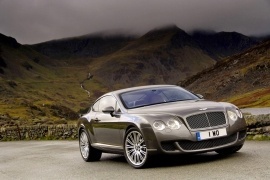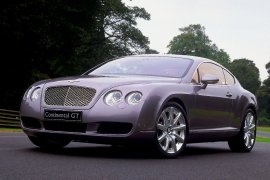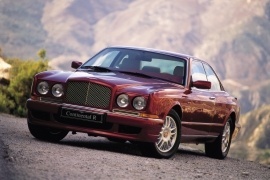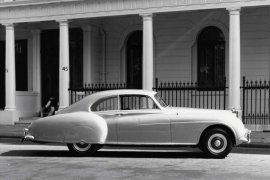
BENTLEY Continental
Generations Timeline, Specs and Pictures

It was the fastest production Bentley ever.
With a speed of 202 mph (325 kph), the Continental GT Speed showed no slow-down in its development program.
After Volkswagen took-over the controls of Bentley, it started to improve the British brand and take it back to its racing roots and its former glory. The entire lineup consisted of gran-tourers and fast, luxurious, limousines. Worth mentioning that they provided the special vehicle for Buckingham palace.
From the outside, the Continental GT Speed featured a wider air intake on the apron and a bigger grille to increase the airflow. Two air-intakes were needed to cool the brakes. The car was fitted with the biggest disc-brakes ever fitted on a production car. On the sides, the big 20” light-alloy wheels were fitted with bespoke Pirelli P-Zero tires.
Inside, the Bentley GT Speed featured carbon fiber and piano-black trims or, for a more refined atmosphere, wood. Despite being the fastest production Bentley ever made, the interior was luxurious as a GT could be. The gear-selector was mounted on the center console, but a pair of paddle-shifters were installed on the steering column. They didn’t rotate with the steering wheel.
From the technical point of view, the car was fitted with the same W12 6.0-liter engine. It was aided by a pair of turbochargers. The connecting rods, the pistons, and the anodized compression ring grooves were new. A lighter distribution chain was installed. The result was a 600 hp engine. It was mated to an 8-speed automatic gearbox that sent the power to all four wheels.

The haters said that the Bentley Continental was the most expensive Volkswagen Phaeton coupe on the planet since the 2003 luxury car was based on the same platform as the German’s flagship vehicle.
It wasn’t completely true since the Continental was tweaked to offer more than any limousine could have offered at that time. First of all, it wasn’t a four-door sedan. In theory, it was a 2+2 GT coupe, which proved that it had only two seats. The rear ones were good enough only for toy-dogs. But it was a fast and proud successor of the Bentley cars.
On the outside, the long, wide and low Continental GT featured a massive front fascia with a big chromed grille. The four-round headlights resembled the Bugatti headlights before WWII when the “Bentley Boys” were flying around the LeMans race-track. Wide-open doors and four power windows and no B-Pillar when those were rolled down inspired a faux-cabriolet body. The sloped rear left no interior headroom for the rear passengers. But who really cared? It was a sculpture in motion.
Inside, the luxurious interior was fitted with the latest features for comfort and safety available at that time. The hand-crafted materials and stitches inspired an exquisite look. There was no room for compromise.
Under the hood, there was a big, 6.0-liter W12 engine that was helped by a pair of turbochargers to develop 600 hp. The only transmission offered was a refined and specially tuned 6-speed ZF automatic, which sent the torque to all four wheels.

In the ’90s, Bentley was nicknamed as the Rolls-Royce for the driver.
Basically, it featured the same luxury, but the cabin was more driver-oriented. It was the same for the Continental R.
In the early ’80s, Rolls-Royce management decided to design a Bentley that would not share the bodywork with a Rolls-Royce. To be offered exclusively as Bentley and resemble the glorious racing history of the B-winged brand. After various delays and stops into the program, the car was officially launched at the 1991 Geneva Motor Show. It was a surprise for everyone: Bentley showed a stunning coupe with the name Continental R. Continental was used by Bentley in the ’50s and the R meant “Roadholding”.
The streamlined bodywork was very long for a coupe. It was longer than a long-wheelbase Mercedes-Benz S-Class from 1991. But the flowing lines of the aerodynamically worked body hid the 5.4 m (210”) long vehicle. The wheelbase measured 3.0 meters (120”). The lowered roof when compared with the Bentley Mulsanne. The mesh-grille looked even more impressive due to its size, between the four rounded headlights designed in an old-fashion way.
The interior was built for comfort. Even though the car resembled a sporty history, it had to be fitted with British luxury. Expensive leather and wood trims were extensively used in the handcrafted cabin. A “Sport” button was installed on the top of the gear selector that would alter the engine and gearbox management and also stiffened the suspension.
The powerful, turbocharged, 6.75-liter V8 was one of the torquiest engines installed in a regular car on those times. And it was upgraded over the years from 650 Nm (450 lb-ft) of torque up to 881 Nm (650 lb-ft) for the 1998.

After the surprising appearance of the Bentley Continental R at the 1991 Geneva Motor Show, the British car-manufacturer was overwhelmed by orders.
Five years later they did a big improvement: the Continental T.
Before Volkswagen bought the Bentley, the British company desperately tried to find a way to build its products and stop being a re-badged Rolls-Royce. The Continental R was showcased as a Rolls-Royce, but the final product was a Bentley and it was enhanced in 1996 by shortening the wheelbase.
Compared to the Continental R, the T version was shorter by 120 mm (4.72”) while the height and width remained the same. The four-round headlamps in the front, the mesh grille, and the corner-mounted slim turn-signals above the bumper were typical for it. Unlike the R version, the rear windows were smaller due to the shorter wheelbase.
Inside, the T desperately tried to resemble the old glorious Bentleys from racing. The designers mounted aluminum on the dashboard and enhanced the view with dials and gauges which nobody read. The adjustable steering column was useful when getting in and out of the car. There were four seats in the cabin, but despite the long wheelbase of 2962 mm (116.6”), there was not too much legroom in the back.
Power came from the legendary 6.75-liter V8 unit, aided by two Cosworth Engineering headers and a big Garret turbocharger. It was mated to a standard, heavy-duty, 4-speed automatic gearbox produced by General Motors. When it was introduced in 1996, then upgraded in 1997, it was the car with the biggest torque on the market.

The Bentley R-Type was designed by the British manufacturer to replace the ‘owner-driver’ Mk IV model on the standard-sedan market.
As compared to its predecessor, this new model came in two different variants - R-Type and R-Type Continental - and featured a larger 4.6L 6-cylinder inline engine delivering a maximum output of 150 hp. Later on, in 1959, the R-Type Continental received a 4.9L unit. In terms of exterior design, the 2-door R-Type Continental was fitted with a longer tail on its standard bodywork and featured almost identical styling to the Rolls-Royce Silver Dawn.























































